In this weeks blog I wanted to shed some light on the journey our stone takes from quarry to you. We will look at the “life cycle” of our stone from when it starts at our quarry all the way through the preparation and transport stages until it reaches its final destination.
Our Quarries
The Armstrongs Group operates 5 quarries in the North West and Cumbria. Those five quarries are located at Brinscall, Montcliffe, Pilkington, Shap and Waddington Fell. Combined they cover 276 Acres with Brinscall covering the smallest area at 40 acres and Waddington Fell covering the highest area at 66 Acres. Both Pilkington and Shap cover 53 Acres whilst Montcliffe is our second largest quarry at 64 Acres. Each one of our five quarries serves a different purpose and yields different stone produce.
Brinscall Quarry
Brinscall Quarry is located near the town of Chorley and has been operational in excess of one hundred years. It produces highly desirable and attractive sandstone and can be used as a building stone, including the present work on the Sagrada Familia cathedral in Barcelona. The Quarry has been worked in the traditional method of crushing and screening following blasting and extraction of dimension stone to produce aggregate materials.
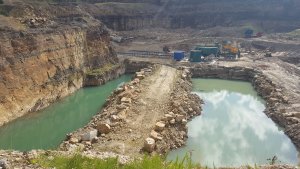
Montcliffe Quarry
Montcliffe Quarry is located near the town of Horwich and has been operational for in excess of one hundred years. It yields a gritstone (a well cemented sandstone) that is also worked in the traditional method of crushing and screening.

Pilkington Quarry
Pilkington Quarry is also located near the town of Horwich and has been operational for in excess of one hundred years. It is split into two sites, Pilkington 1 and Pilkington 2. Pilkington 1 is exhausted but carries permissions to receive 2M tonnes of inert waste. Pilkington 2 is as yet unmined but carries a pale buff/brown highly durable gritstone.

Shap Quarry
Shap Quarry is located in Cumbria near the village of Shap and has been in operation since 1950. It is the home of Shap Pink granite, a widely used decorative building stone. The site yields two types of stone, Light Shap primarily worked as aggregate and Dark Shap used architecturally. It is also worked traditionally with high demand presently for Rock Armour to build sea and river defences.
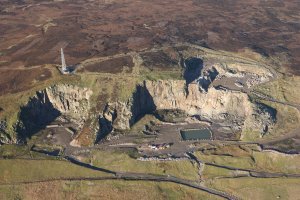
Waddington Fell Quarry
Finally,
Waddington Fell is located near the town of Clitheroe, and has been operational since the 1960’s. The quarry offers a range of sandstones, variable in strength and colour. Waddington Fell has also been worked in the traditional method of crushing and screening following blasting. The stone from Waddington fell also forms excellent cut products such as fireplaces, lintels, even complete houses.

Our Products
As you can see from the rundown of our quarries we offer a vast array of products to suit every need. Each product comes from our own stone and this allows us to have strict quality control and provide the highest quality products and material available.
Aggregates
The most popular of our products is
Aggregates. Aggregates are a form of coarse to medium grained material made from stone and used mainly in construction. There are a number of different shapes and sizes of aggregates such as: Sand, Crushed Stone & Gravel to name a few.There are lots of uses for aggregates in construction and they make up a variety of products and building materials.We supply aggregates of all sizes for a range of applications including concrete production, Pathways/ Driveways and Sea Defence. Click Picture to enlarge.
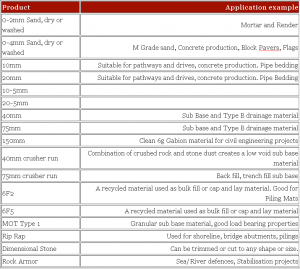
Cut Stone and Dimensional Stone
The Armstrongs Group has a range of fixed blade and wire saws that enable our stonemasons to supply an extensive range of
architectural stonework including Window Cills, Lintels, Fence posts and Door Surrounds.All of our work is bespoke to your requirements and we are involved in many types of projects ranging from refurbishment and renovation to new build.
Ready Mix Concrete
We can also supply any mix design of
ready mix concrete you require for the job. These range from GEN1 to RC50 (footings to motorway precast concrete) via our
AMIX Concrete Plant. AMIX Concrete use pure Portland cement in all our mixes so you can be guaranteed consistent quality every time.
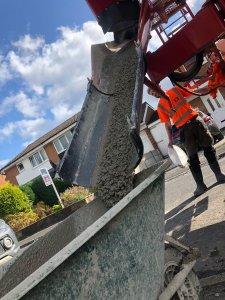
Armstrongs Group also supply a full range of admixtures. Examples of this are: liquid retarder, during hot weather and AEA (air entraining agent) which prevents cracking of hardened concrete during extreme freeze thaw temperatures. We also provide accelerator admixtures which will provide seven day strength within 24 hours of placement.
How is our stone extracted?
Depending on the product we have different ways of extracting the stone from our quarries. The most traditional way of extracting stone is via blasting the rock face.
Blasts
Blasts are used to extract large amounts of stone from the rock face and are an efficient way of extracting. The blast technician will identify where on the rock face we are going to blast and then prepare the area in advance. A few days before the blast the blast technician will drill into the rock face at a vertical angle, they will do this at a few points along the rock face in order to make holes for the explosives.On the day of the blast the explosives will be lowered into the holes along the rock face before being detonated from a safe distance. The stone that is dislodged is then used for aggregates whilst the larger stone pieces are either broken down to be used as aggregates or potentially used for dimensional stone products.
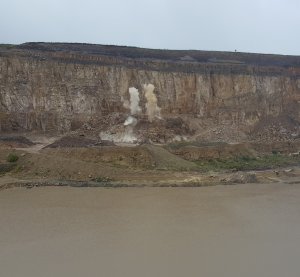
Manual Excavation
As previously mentioned in our
La Sagrada Familia blog for more delicate stone products such as some dimensional stone or cut stone products, we will manually extract the stone from the rock face.Rather than blasting an entire rock face at some height, there is a more methodical process to extracting our stone manually. Extracting downwards in stages is a more logical process in order to keep the stone in the best condition possible.

Our excavator, with its ripper attachment, carefully uses the rocks natural cracks to dislodge the stone . Once the stone is dislodged a wheel loader collects it and transports it to safer grounds away from the extraction site. However, if the stone is too large to transport then we have a unique way of solving this. The loader will load a large metal ball into its bucket and from a height of around 3 metres drops it onto the larger stone below. This actions breaks it into smaller more easier pieces where it is then transported to its next location.
What happens next?
Once the stone is extracted there are a number of different processes that we undertake depending on the finished product.
Screening, Crushing & Washing
To prepare and produce our aggregates we go through a screening process. Screening helps classify the aggregates by size before separating them into piles at different points of the plant. Some aggregates are crushed into smaller sizes however all our aggregates are fed through a washing plant.
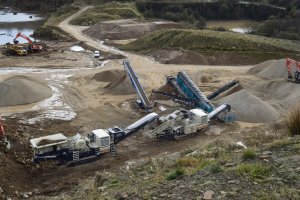
Washing is an aggregate standard procedure by which aggregate is washed to make it meet production specifications. However, there is more to the function of water in the aggregate producing procedure. Washing is used to remove clay, silt and other materials such as coal, roots, shale and twigs. The water in the washing process also helps with sizing and separating aggregate as well as dewatering produce like sand.Once the aggregate has undergone the screening process it is now ready for sale and is used in a number of different applications dependant on its size.
Ready Mix Concrete
We use our own aggregates to create high quality concrete. Once our aggregates have been crushed and screened we use our 0mm-20mm products to mix with a paste made from cement and water. This paste coats the aggregates creating a rock like texture. This produces our high quality ready mix concrete ready for sale.
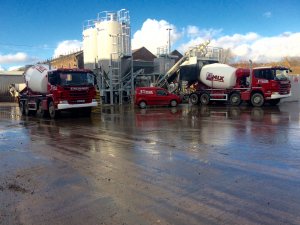
Wire and Fixed Blade Saws
We have a range of saws capable of fulfilling any jobs. Once the stone is extracted from our quarries they are transported to our stone yard. Here the stone is checked, identified and separated by our stone masons ready to be cut to shape.
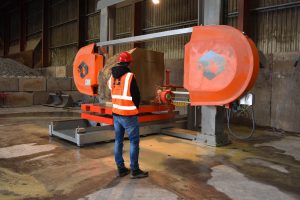
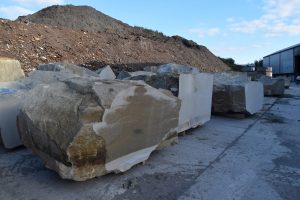
Dimensional stone is a popular stone that has been cut to specific shape for use in building and infrastructure work. Our saws cut a section of the stone off to assess the quality before cutting into the final product. Our saws can cut any shape or size from paving stones to large signs.
Hand Finished Bespoke Cut Stone
Once the stone is cut into the desired shape and size some of our products require a hand finish. Our stonemasons work with precision and care to finish off our bespoke products to our clients exact specifications.

Once all the steps above have been completed for each of our products (Aggregates, Concrete, Cut Stone) they are now ready to be shipped directly to you or they are available collection if so desired.For more information about the products we sell and their life journey from each of our quarries directly to you,
get in touch.











 Armstrongs Group also supply a full range of admixtures. Examples of this are: liquid retarder, during hot weather and AEA (air entraining agent) which prevents cracking of hardened concrete during extreme freeze thaw temperatures. We also provide accelerator admixtures which will provide seven day strength within 24 hours of placement.
Armstrongs Group also supply a full range of admixtures. Examples of this are: liquid retarder, during hot weather and AEA (air entraining agent) which prevents cracking of hardened concrete during extreme freeze thaw temperatures. We also provide accelerator admixtures which will provide seven day strength within 24 hours of placement.
 Our excavator, with its ripper attachment, carefully uses the rocks natural cracks to dislodge the stone . Once the stone is dislodged a wheel loader collects it and transports it to safer grounds away from the extraction site. However, if the stone is too large to transport then we have a unique way of solving this. The loader will load a large metal ball into its bucket and from a height of around 3 metres drops it onto the larger stone below. This actions breaks it into smaller more easier pieces where it is then transported to its next location.
Our excavator, with its ripper attachment, carefully uses the rocks natural cracks to dislodge the stone . Once the stone is dislodged a wheel loader collects it and transports it to safer grounds away from the extraction site. However, if the stone is too large to transport then we have a unique way of solving this. The loader will load a large metal ball into its bucket and from a height of around 3 metres drops it onto the larger stone below. This actions breaks it into smaller more easier pieces where it is then transported to its next location. Washing is an aggregate standard procedure by which aggregate is washed to make it meet production specifications. However, there is more to the function of water in the aggregate producing procedure. Washing is used to remove clay, silt and other materials such as coal, roots, shale and twigs. The water in the washing process also helps with sizing and separating aggregate as well as dewatering produce like sand.Once the aggregate has undergone the screening process it is now ready for sale and is used in a number of different applications dependant on its size.
Washing is an aggregate standard procedure by which aggregate is washed to make it meet production specifications. However, there is more to the function of water in the aggregate producing procedure. Washing is used to remove clay, silt and other materials such as coal, roots, shale and twigs. The water in the washing process also helps with sizing and separating aggregate as well as dewatering produce like sand.Once the aggregate has undergone the screening process it is now ready for sale and is used in a number of different applications dependant on its size.

 Dimensional stone is a popular stone that has been cut to specific shape for use in building and infrastructure work. Our saws cut a section of the stone off to assess the quality before cutting into the final product. Our saws can cut any shape or size from paving stones to large signs.
Dimensional stone is a popular stone that has been cut to specific shape for use in building and infrastructure work. Our saws cut a section of the stone off to assess the quality before cutting into the final product. Our saws can cut any shape or size from paving stones to large signs. Once all the steps above have been completed for each of our products (Aggregates, Concrete, Cut Stone) they are now ready to be shipped directly to you or they are available collection if so desired.For more information about the products we sell and their life journey from each of our quarries directly to you, get in touch.
Once all the steps above have been completed for each of our products (Aggregates, Concrete, Cut Stone) they are now ready to be shipped directly to you or they are available collection if so desired.For more information about the products we sell and their life journey from each of our quarries directly to you, get in touch.